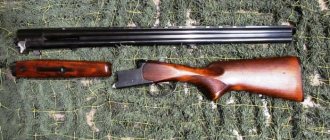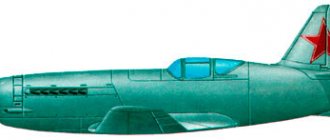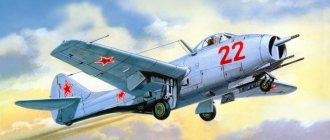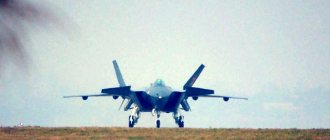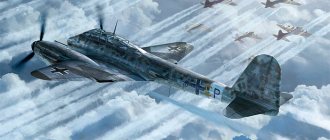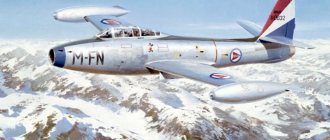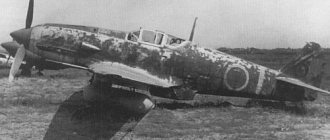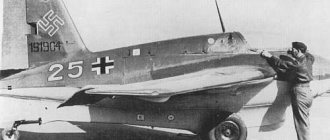people's fighter Luftwaffe Heinkel He-162 Salamander
One of the most interesting completed Luftwaffe aircraft projects is the “people’s fighter,” conceived as an extremely simple machine designed for mass production from scarce materials using low-skilled labor. The requirements were sent to leading aviation companies on September 8, 1944. They provided for the creation of a single-engine aircraft weighing no more than 2000 kg with a BMW 003 turbojet engine, armament from 1-2 30-mm cannons, a speed of 745 km/h and a flight duration of 30 minutes. The fighter was supposed to be ready for serial production before January 1, 1945!
On September 30, 1944, the winner was determined - project R. 1073. The aircraft was a high-wing aircraft of mixed construction (a light alloy fuselage with a wooden nose cone, a wooden wing with plywood sheathing and metal tips) with a two-fin tail. The engine was installed on the fuselage behind the cockpit. By October 29, design documentation was ready and construction of prototypes began. At the same time, assembly lines were being prepared at Marien, Junkers-Mittelwerk in Nordhausen, and at the Hinterbrühl plant. It was planned to build 1,000 “people's fighters” by April 1945, and to produce 2,000 vehicles monthly from May. The first experimental He-162V1 entered testing on December 6, 1944.
History of the creation of the He-162 fighter
By the end of the war, the Allies were literally bombarding Germany with bombs, and piston fighters were no longer nearly as effective against the armadas of “flying fortresses.” FOR this reason, in the fall of 1944, the designers began the Salamander project, the result of which was to be a new jet fighter - high-speed and well-armed, but very easy to fly. The plane itself was dubbed "Volksjager", that is, the people's fighter, but "according to science" the future He-162 was called "Spatz" ("Sparrow") .
He-162 fighter jet
They took up the work so zealously that they were even ahead of Soviet designers in terms of the speed of work - according to the plan, 4 months were allotted for the creation of the jet He-162 (deadline - 01/01/45), but already on December 6, 1944, the He-162 made its first flight.
By the way, the He-162 was never called “Salamander”; I repeat, this name was given to the project to create the aircraft itself.
The design of the He-162 jet fighter
The He-162 aircraft had an extremely simple and technologically advanced design. Contrary to its Art Nouveau appearance, the fighter was made of wood - only the wingtips were metal, and the nose of the aircraft was made of pressed plywood.
He-162 drawing
The wheels and brakes for the He-162 were borrowed from the Me-109, and the starter - a two-stroke Riedel piston engine - from the Me-262. The armament consisted of cannons mounted symmetrically in the lower front part of the fuselage. As a result of the first flight, carried out on December 6, 1944 by flying captain Peter, a maximum speed of 840 km/h was achieved.
The He-162's cockpit was equipped with an ejection seat, ejected using an explosive charge.
Production and combat use of the He-162 fighter
The “people's fighter” He-162 in practice turned out to be very difficult to control and, alas, was in no way suitable for the role of a mass-produced aircraft. However, a drowning man clutches at every straw, and the He-162 was supposed to be built on an unprecedented scale - 2000 vehicles per month.
The first fighters began to enter service with the Luftwaffe in January 1945. They were equipped with the 1st and 2nd squadrons of the JG 1 aircraft squadron under Oberst-Leutnant Herbert Ihlefeld, but both formations could not be brought to combat readiness. Despite Napoleonic plans, Germany managed to produce and put into service no more than 120 He-162 jet fighters; the fate of about fifty more finished vehicles is unknown. By the end of the war, approximately 900-1000 more vehicles of this type were undergoing flight tests, or were in varying degrees of readiness at factories (about 800 vehicles).
He-162 fighter jet
The German command placed high bets on the Heinkel-162 jet, however, this was already a gesture of desperation, and not a seriously thought-out combination.
Firstly, the plane was far from “as simple” as we would like, and at the end of the war there was nowhere to find experienced pilots. For example, despite the fact that the plane easily crossed the 800 km/h bar, the pilots were strictly forbidden to perform turns at speeds above 500 km/h, otherwise the plane would fall into a tailspin. What kind of air combat can we talk about in such conditions?
Secondly, the car was, to put it mildly, “raw” - of the 13 He-162s lost by the 1st squadron of JG 1, 3 were shot down by the enemy - all the rest suffered accidents due to technical defects.
Thirdly, 120 (even if 170) vehicles are far from the thousands that were planned to be put into service from January to May 1945.
The only known victory in air combat on the He-162 took place on May 04, 1945 (pilot - Lieutenant Rudolf Schmidt), but it is not indisputable (air defense was actively working in the area). After the war, the fighter was not used by either side of the conflict.
Links[edit]
- Green 1972, pp. 592-593.
- Gladniker, David. "An Incomplete Guide to Using an Airfoil". m-selig.ae.illinois.edu
. Retrieved April 16, 2022.
- Green, William. Combat aircraft of the Third Reich
. New York: Doubleday, 1972. ISBN 0-385-05782-2. - Wagner, Ray and Heinz Novarra. German Fighting Aircraft: A Comprehensive Survey and History of the Development of German Military Aircraft from 1914 to 1945
. New York: Doubleday, 1971.
Characteristics of the He-162
A country:GermanyType:Jet fighterYear of issue:1944Crew:1 personEngine:1×BMW 003E-1Maximum speed:up to 900 km/hPractical ceiling:12 kmRange of flight:975 kmEmpty weight:1.66 tMaximum take-off weight:2.8 tWingspan:7.2 mLength:9.05 mHeight:2.6 mWing area:14.5 sq.m.Weapons:2× 30 mm MK 108
Characteristics given for He-162 A-0
Non-162 Salamander - the jet “people's fighter” of the Third Reich
The He-162 Salamander fighter today evokes in many people respect for the incredible efforts that the German aircraft industry made in the rather terrible conditions of the end of World War II. Only 69 days separated the start of construction of the He-162 fighter from the flight of the first prototype of the machine, which took place in December 1944. Designed as a turbojet fighter-interceptor, the aircraft was built using wood to reduce cost and ease of production. Now it’s impossible to believe, but German industry was going to build up to 4,000 of these aircraft per month. Naturally, these figures were utopian.
The history of the creation of this fighter is probably the most exciting of all combat aircraft ever created. The idea of building the so-called "Volksjager" - the "people's fighter" - was born in the mind of the head of the specially created "fighter headquarters" Otto Saur, who was a protégé of the German Minister of Arms Albert Speer. From the origin of the idea to the construction of the first aircraft, only 90 days passed! The idea of the "people's fighter" envisioned the development of a cheap, simple fighter that would be suitable for mass production using low-skilled labor and cheap materials.
The reason for the birth of this idea was the weakness of the German air defense system, which by the autumn of 1944 had already become quite obvious to the leadership of the Third Reich. Taking this into account, the German Ministry of Aviation adopted the idea of holding a competition for the development of a jet fighter, which was supposed to be produced in fairly large volumes - from 1000 to 5000 fighters monthly. The competitive conditions were sent to all major aircraft manufacturing companies in the country and contained a list of the following tactical and technical requirements for the future aircraft:
Maximum speed up to 750 km/h BMW-003 engine with a thrust of 800 kgf. Specific wing load no more than 200 kg/m2 Maximum flight time at the ground 20 minutes. Armament: 1 or 2 MK-108 cannons. The maximum take-off range of the aircraft is no more than 0.5 km. The armor weight is no more than 50 kg, it was supposed to be used only at the front. The take-off weight of the aircraft is no more than 2000 kg.
In addition, the requirements included the simplicity of the machine’s equipment, reduced production costs, and ease of piloting. It was also interesting that it was decided to use wood in the construction of the wings.
received all the documents necessary for this competition on September 8, 1944, and already on September 24, a group of designers of the company located in Vienna began design work on the future fighter, which received the designation He-162 and the factory designation “Salamander”. By the beginning of November, they had prepared working drawings of the machine, and as the drawings were ready, the production of individual units and components of the fighter was carried out. All this made it possible to complete work on the interceptor fighter by December 6, 1944. On the same day, the first He-162 took off.
Description of design
The Heinkel He-162 was a single-seat, single-engine fighter aircraft powered by a turbojet engine. It was a high-wing aircraft of a mixed design with a spaced vertical tail and a three-post landing gear, the front strut of which was steerable.
The front part of the fuselage up to the wing was detachable monocoque type, the rest of the fuselage was semi-monocoque. The structure was mainly metal, while the landing gear compartment doors, nose cone, battery compartment cover, weapons hatches, and the inner walls of the fuselage fuel tank compartment were made of wood. A wing was mounted on top behind the cockpit, and the engine nacelle was installed above it. The plane was distinguished by an unusual top-mounted engine. The turbojet engine was mounted on the fuselage crest at the front with 2 vertical bolts, and at the rear with 2 horizontal bolts.
The plane's wing was made of wood. It was one-piece, trapezoidal and two-spar. Its working skin had a thickness of 4-5 mm. and was plywood. Only the wingtips were duralumin, which deviated downward at an angle of 55 degrees. The wing was attached to the fuselage of the fighter using 4 bolts. There were 2 small fuel tanks located between the wing spars. The flaps and ailerons were also made of wood. The flaps were driven hydraulically, and the ailerons driven mechanically.
The aircraft's landing gear was three-post and retractable. The front landing gear in the retracted position was located in a special niche located under the instrument panel. The front wheel size was 380 by 150 mm, and Buna or Continental tires were used on the A-pillar. The main landing gear was of a cantilever type and was attached to the fuselage of the vehicle and retracted back into it against the direction of flight. The main landing gear wheels measured 660 by 190 mm. The landing gear retraction drive was hydraulic, and the landing gear release drive was a mechanical spring drive. The chassis was damped with oil. The chassis was equipped with drum brakes. The landing gear niche doors were also made of wood, but were reinforced with duralumin elements.
The cockpit canopy was made of plexiglass and had two sections. The rear part of the lantern tilted back and up; in the open position it could be secured using a stop and a lock. On the left side of the cockpit canopy there was a glazed round ventilation window. The plane's cabin was not pressurized. The cockpit was equipped with two types of collimator sight, Revi 16A or Revi 16B, which was mounted on a special bracket mounted above the instrument panel. Navigation instruments, engine control devices, and radio equipment were located on the dashboard and partially on the side consoles. The pilot's seat on this fighter was ejectable, was adapted for stowing a parachute, and used a powder charge. An armor plate was located immediately behind the pilot's seat.
The fighter was equipped with a BMW-003E1 turbojet engine with a thrust of 800 kgf. The engine allowed the aircraft to reach speeds of around 900 km/h at altitude. The fuel supply was 945 liters, of which 763 liters were in the fuselage tank, which was located immediately behind the flight seat, another 182 liters were in 2 wing tanks.
The aircraft's armament consisted of 2 automatic cannons, which varied depending on the modification of the aircraft. In the He-162 A-1 modification, these were 30-mm Rheinmetall-Borsig MK 108 cannons with 50 rounds of ammunition per barrel; in the He-162 A-2 modification, two automatic 20-mm Mauser MG 151/20 cannons were used with an ammunition capacity of 120 shells per barrel. During the firing process, cartridges and chain links were thrown out through special holes in the lower part of the aircraft fuselage. The reloading and release of the MG 151/20 guns was electric, while the MK 108 guns were electro-pneumatic.
Production and combat use
To ensure the production of Non-162 fighters in the face of incessant Allied air raids, most of the enterprises were moved underground. It was only in the abandoned gypsum mines in Mödling (near Vienna) that the Allies discovered an assembly plant, in the workshops of which more than 1,000 He-162 fighters were found at various stages of readiness. Serial production of this aircraft began only in January 1945, when the first 6 aircraft were assembled. In total, before the end of the war, the enterprises handed over about 120 aircraft to Luftwaffe units, and more than 200 aircraft were undergoing factory tests at that time.
Despite its high performance characteristics, the Salamander never became a lifesaver for the Luftwaffe. There is no reliable data on the number of Allied aircraft they shot down, but the count here is down to just a few. This was largely due to the fact that the “people’s fighter” was not a plane for beginners. The Ne-162 had an unstable pitch due to the engine being mounted above the fuselage. The fighter was not the most pleasant machine to fly, which required great care from the pilot. It is no coincidence that the first rule for pilots of these fighters was: “Always operate the control stick smoothly - no sudden maneuvers, no sudden movements!” Even experienced pilots needed to undergo significant flight training in order to get used to the fighter and develop the necessary “feel for the machine.”
All this led to numerous accidents and disasters involving these aircraft. Many of them were due to design miscalculations, as well as manufacturing defects in fighter aircraft. So, only within 3 weeks from April 13 until the end of the war, the 1st squadron of the 1st squadron, which was armed with Non-162 fighters, lost 13 fighters and 10 pilots. Moreover, only 3 fighters were shot down by the Allies, the rest were non-combat losses. Thus, in this squadron alone there was an average of 1 accident every 2 days.
Separately, it is worth noting that all these results must be considered in the context of the total collapse of the armed forces and industry of Germany in the final months of the war as a result of the actually accomplished defeat of the Reich. If this fighter had reached combat units at least a year earlier, the results of its combat use could have been completely different.
Performance characteristics of He-162a-2
Dimensions: wingspan - 7.02 m, length - 9.03 m, height - 2.6 m. Wing area - 11.1 sq. m. Aircraft weight, kg - empty - 1,664 - normal take-off - 2,600 - maximum take-off - 2,800 Engine type - 1 BMW-003 turbojet engine, thrust 800 kgf. The maximum speed at altitude is 900 km/h. Practical range – 970 km. Service ceiling – 12,000 m. Crew – 1 person. Armament: 2x20-mm MG-151/20 cannons with 120 rounds per barrel.
Sources used: www.airpages.ru/lw/he162.shtml www.pro-samolet.ru/samolety-germany-ww2/reaktiv/200-he-162-salamandra www.airwar.ru/enc/fww2/he162.html www.airx.ru/planes/he162/he162.html
